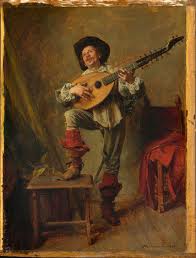Period Chamber Music: Museum Piece or Modern Performance?

By James Ranson
A few weeks ago, a concert as trendy as one by Lady Gaga or Michael Jackson was performed in Pittsburgh. Really. I’m not making this up. But if you missed the performance, don’t panic. You’re not out of the Top 40 radio loop. The concert I’m referring to was performed by Pittsburgh period chamber group Chatham Baroque, and its program notes specifically related the concert’s music to modern icons like Gaga and the King of Pop. It makes sense – in the 16th, 17th and 18th centuries, chamber music was pop music. The chansons, motets, sinfonias and other period pieces performed at that concert could have been lifted from a radio playlist circa 1600, had such a thing existed.
But as the saying goes: that was then, this is now. The beautiful church hall where Chatham Baroque performed still had room in the seats, and it is not an easy thing to attract younger audiences to events such as Baroque music. Yes, the comparison to Lady Gaga is accurate, but the fact that period chamber music is not a wildly popular performance type in 2011 is not news. The consequence is that many, many people regularly miss out on beautiful, engaging and edifying performances, and that most of those same people don’t even know what they missed. Words like theorbo and dulcian, if they’ve even heard them before, seem foreign and distant, not to mention the works composed for these instruments. So when I left the concert hall that October evening, I wondered whether period chamber music can exist as anything other than a museum piece and was not entirely optimistic about what conclusion I might reach.
But then I met Crystal Manich. An opera director by trade, Manich co-owns Opera Omnia, a New York City company that performs only 17th-century operas and uses small-scale orchestras made up of period instruments. In 2008, Opera Omnia performed Coronation of Poppea, a Monteverdi opera from the 1640s, to rave reviews, and this year they put on Francesco Cavalli’s Giasone from the same decade. When asked about the audience response to Opera Omnia’s period works, Manich smiles and says “it’s great. We get full and nearly-full houses. People come in for a drink and to see maybe the first act, and then end up staying for the whole show.”
Wait—a drink? At a period opera? No, I’m not making that up either. Opera Omnia performs in Le
Poisson Rouge, a self-proclaimed “arts bar” whose stage has not only hosted classical acts like the Calder String Quartet and composers Philip Glass and John Adams, but also modern musicians like Moby, Paul Simon, Florence and the Machine, Mos Def, and They Might Be Giants. Le Poisson Rouge is a working bar, founded by musicians, whose mission is “to revive the symbiotic relationship between art and revelry.”
So maybe the problem isn’t the period music itself, but the venue and presentation in which people are invited (or, by default, required) to see it in. Manich points to the hip, artsy and social environment of Le Poisson Rouge as a significant factor in Opera Omnia’s draw, also noting that the intimate setting allows the audience to experience the period music up close—often from mere feet away. “We also use modern staging and contemporary costumes, and the texts are sung in English, which all help make the works more accessible.” she adds.
Mentally, I contrast this experience with the Chatham Baroque concert, and I begin to wonder if that group’s excellent musical sound would sound out of place in a similar venue in Pittsburgh. After all, period works both vocal and instrumental were written not for large-scale concert halls but for smaller, informal settings. And before time turned them into concert works, many of these pieces were songs and dances, types of revelry. So there we have the mission of Le Poisson Rouge again: could a small ensemble reach new audiences and grow as an organization by simply changing its venue? And by extension, could adopting a revelry- and social-venue based performance practice revive struggling period groups nationwide? Yet I am just anticipating what is already on their minds as well. Chatham Baroque, for example, is doing a number of things to shake up conventions in venue and audience outreach – such as playing in Mellon Park, gallery crawls, and other settings outside a concert hall – and they are doing their part to reach children with a series of “Peanut Butter and Jam” daytime concerts targeted to our youngest music lovers. More broadly, Chatham Baroque’s Executive Director, Marc Giosi, writes in this very issue of The Muse Dialogue about some innovative thinking that can help to bridge the gap to new audiences (click here for Marc Giosi’s “Tweets, Texts and Tchaikovsky”).
Clearly this train of thought is in some respects just about returning chamber music to the smaller settings that were its home in the first place, and it seems to me that moving in such a direction could work well. At the very least, I’d probably have a pretty easy time inviting even nonmusical friends to a concert at a bar—and after the concert, I could just smile when they tell me, “Hey, that theorbo was cool!”
Links:
Chatham Baroque: http://www.chathambaroque.org/
Opera Omnia: http://www.operaomnia.org/
Le Poisson Rouge: http://lepoissonrouge.com/venue
For related articles from The Muse Dialogue:
Tweets, Texts, and Tchaikovsky: Live Concerts for a Contemporary Audience











